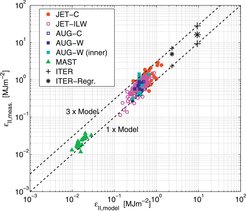Detailed data analysis allows precise predictions of divertor heat loads for ITER
Based on data from several european fusion experiments, a team led by IPP scientists has constructed a model, which allows precise predictions of heat fluxes for the design of ITER
ITER is the next big step on the way to a future CO2-free and safe energy supply by fusion power plants. This experiment, which is currently being built in France, carries many genes of IPP’s experiment ASDEX Upgrade. In particular ITER is supposed to be operated in the so-called H-mode scenario. H-mode stands for an especially beneficial plasma confinement, the “high confinement mode”, which was discovered at IPP already in 1982.
This good confinement of energy and particles in the hot fusion plasma is, however, accompanied by periodically modulated heat flux bursts to the inner wall of the reactor. These are caused by magnetohydrodynamic modes in the plasma edge and might limit the life time of the wall components.
To obtain a commercially beneficial long operation time of a fusion reactor, precise statements on the usability of specific materials as well as on the ability to optimise plasma parameters are required. For this purpose a team led by IPP scientists analysed such heat flux data in a very detailed manner.

For this purpose data from the fusion experiments MAST (England), ASDEX Upgrade (IPP), and JET (EUROfusion) were combined and a model for the extrapolation to ITER and future reactors was developed. Here the combination of these three European experiments is essential, because besides the influence of the plasma parameters, like the pressure at the plasma edge, this also allows to determine the influence of the machine size. It should be mentioned that in terms of the radius ITER is twice the size of JET, four times the size of ASDEX Upgrade, and eight times the size of MAST.
In simple words, the model describes the heat flux to the wall to increase with the product of radius and plasma pressure. The comparison of the model calculation with experimental data is shown in the graph together with predicted values for ITER.
In summary one can say that the model developed at IPP allows more precise projections of the heat fluxes for ITER, which are in addition more favourable. In the future these values will be employed for the design of ITER.
This work has recently been published by T. Eich, B. Sieglin and co-workers in "Nuclear Materials and Energy":
https://doi.org/10.1016/j.nme.2017.04.014
